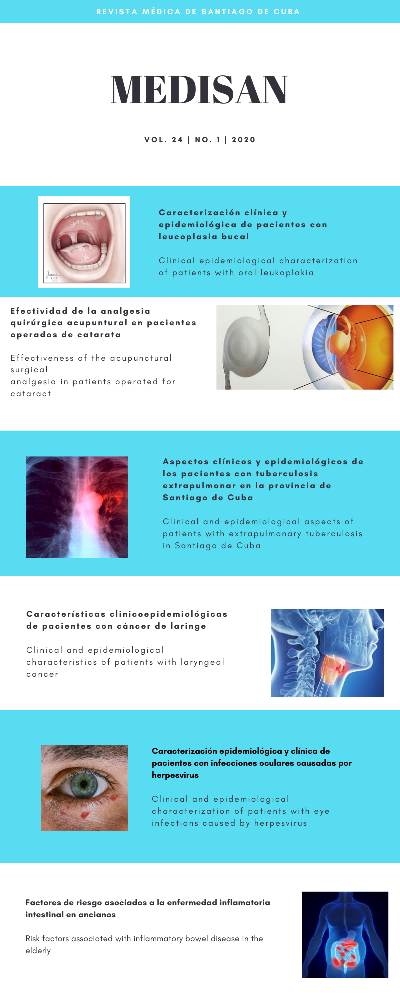Algunas consideraciones sobre la trocleoplastia del fémur
Palabras clave:
mala alineación patelofemoral, displasia del fémur distal, displasia de la tróclea, tomografía axial computarizada.Resumen
La mala alineación patelofemoral tiene múltiples causas anatómicas y una de ellas es la displasia de la tróclea del fémur distal, por lo cual su tratamiento depende de varios factores. Para profundizar en los elementos esenciales de la técnica de trocleoplastia, se realizó una revisión bibliográfica exhaustiva donde se analizaron algunos aspectos de interés, a saber: clasificación más empleada para las displasias de la tróclea, elementos imagenológicos más importantes, indicaciones de la técnica quirúrgica, contraindicaciones, principales modalidades de trocleoplastia y vías de acceso quirúrgico. Se concluyó que este es un proceder con indicaciones muy específicas y puede realizarse mediante cirugía abierta o por vía artroscópica.
Descargas
Citas
2. Dejour D, Renato P, Saggin R. Sulcus deepening trochleoplasty. En: Sanchis Alfonso V. Atlas of Patellofemoral Joint. London: Springer Verlag; 2013.p.211-5.
3. Carstensen SE, Menzer HM, Diduch DR. Patellar Instability: When is Trochleoplasty Necessary? Sports Med Arthrosc Rev. 2017 [citado 15/08/2018]; 25(2). Disponible en: https://www.ncbi.nlm.nih.gov/pubmed/28459752
4. Tigchelaar S, van Sambeeck J, Koeter S, van Kampen A. A stand-alone lateral condyle-elevating trochlear osteotomy leads to high residual instability but no excessive increase in patellofemoral osteoarthritis at 12-year follow-up. Knee Surg Sports Traumatol Arthrosc. 2018 [citado 15/08/ 2018]; 26(4). Disponible en: https://www.ncbi.nlm.nih.gov/pmc/articles/PMC5876279/pdf/167_2017_Article_4602.pdf
5. Dietrich TJ, Fucentese SF, Pfirrmann CW. Imaging of individual anatomical risk factors for patellar instability. Semin Musculoskelet Radiol. 2016 [citado 09/08/2018]; 20(1). Disponible en: https://www.thieme-connect.com/products/ejournals/pdf/10.1055/s-0036-1579675.pdf
6. Nolan JE 3 rd, Schottel PC, Endres NK. Trocheleoplasty: indications and technique. Curr Rev Musculoskelet Med. 2018 [citado 10/08/2018]; 11. Disponible en: https://www.ncbi.nlm.nih.gov/pmc/articles/PMC5970113/pdf/12178_2018_Article_9478.pdf
7. Zaffagnini S, Grassi A, Zoccvo G, Rosa MA, Signorelli C, Muccioli GMM. The patellofemoral joint: dysplasia to dislocation. EFORT Open Rev. 2017 [Citado 10/08/2018]; 2(5). Disponible en: https://www.ncbi.nlm.nih.gov/pmc/articles/PMC5467684/pdf/eor-2-204.pdf
8. Dejour D, Renato P, Saggin R. Sulcus deepening trochleoplasty. En: Sanchis Alfonso V. Anterior Knee Pain and Patellar Instability. London: Springer Verlag; 2011.p.423-32.
9. Hiemstra LA, Peterson D, Youssef M, Soliman J, Banfield L, Ayeni OR. Trochleoplasty provides good clinical outcomes and an acceptable complication profile in both short and long-term follow-up. Knee Surg Sports Traumatol Arthrosc. 2019 [citado 09/12/ 2019];27(9). Disponible en: https://link.springer.com/article/10.1007%2Fs00167-018-5311
10. Balcarek P, Zimmermann F. Deepening trochleoplasty and medial patellofemoral ligament reconstruction normalize patellotrochlear congruence in severe trochlear dysplasia. Bone Joint J. 2019 [citado 08/12/2019];101(3). Disponible en: https://online.boneandjoint.org.uk/doi/abs/10.1302/0301-620X.101B3.BJJ-2018-0795.R2
11. Bauduin E, Putman S, Migaud H, Remy F, Debuyzer E, Pasquier G. Compared outcomes 16 and 25 years after lateral wedge augmentation trochleoplasty: rate of recurrent dislocation and progression to osteoarthritis. Orthop Traumatol Surg Res. 2019 [citado 10/12/2019];105(7). Disponible en: https://www.sciencedirect.com/science/article/abs/pii/S1877056819302798?via%3Dihub
12. Petri M, Ettinger M, Stuebig T, Brand S, Krettek C, Jagodzinski M, et al. Current concepts for patellar dislocation. Arch Trauma Res. 2015 [citado 10/12/2019];4(3): Disponible en: https://www.ncbi.nlm.nih.gov/pmc/articles/PMC4636822/pdf/atr-04-03-29301.pdf
13. Berruto M, Uboldi FM, Ferrua P, Vergottini G, Manunta A. Surgical treatment of objective patellar instability: long-term results. Joints. 2018 [citado 15/08/2018]; 6(1). Disponible en: https://www.ncbi.nlm.nih.gov/pmc/articles/PMC5906118/pdf/10-1055-s-0038-1636949.pdf
14. Longo UG, Vincenzo C, Mannering N, Ciuffreda M, Salvatore G, Berton A, et al. Trochleoplasty techniques provide good clinical results in patients with trochlear dysplasia. Knee Surg Sports Traumatol Arthrosc. 2018 [citado 11/12/2019]; 26(9. Disponible en: https://www.ncbi.nlm.nih.gov/pubmed/28567511
15. Dejour D, Byn P, Saggin R. Deepening Trochleoplasty for Patellar Instability. En: Zaffagnini S. Patellofemoral, Pain, Instability, and Arthritis. Berlin: Springer Verlag; 2010.p.225-32.
16. Ren B, Zhang X, Zhang L, Zhang M, Liu Y, Tian B, et a. Isolated trochleoplasty for recurrent patellar dislocation has lower outcome and higher residual instability compared with combined MPFL and trochleoplasty: a systematic review. Arch Orthop Traumatol Surg. 2019 [citado 14/12/ 2019]; 139(11). Disponible en: https://link.springer.com/article/10.1007%2Fs00402-019-03244-1
17. Dejour D, Byn P, Ntagiopoulos PG. The Lyon's sulcus-deepening trochleoplasty in previous unsuccessful patellofemoral surgery. Int Orthop. 2013 [citado 15/08/2018]; 37(3). Disponible en: https://www.ncbi.nlm.nih.gov/pmc/articles/PMC3580087/pdf/264_2012_Article_1746.pdf
18. Zaffagnini S, Previtali D, Tamborini S, Pagliazzi G, Filardo G, Candrian C. Recurrent patellar dislocations: trochleoplasty improves the results of medial patellofemoral ligament surgery only in severe trochlear dysplasia. Knee Surg Sports Traumatol Arthrosc. 2019 [citado 11/12/2019]; 27(11). Disponible en: https://link.springer.com/article/10.1007%2Fs00167-019-05469-4
19. Koh JL, Stewart C. Patellar instability. Orthop Clin North Am. 2015 [citado 10/12/2019];46(1). Disponible en: https://www.sciencedirect.com/science/article/abs/pii/S0030589814001448?via%3Dihub
20. Dejour D, Paulo R, Saggin RF, Kuhn VC. Sulcus Deepening Trochleoplasty. En: Scott WN. Insall & Scott Surgery of the Knee. 6 ed. Philadelphia: Elsevier; 2018.p.954-66.
Publicado
Cómo citar
Número
Sección
Licencia
Esta revista provee acceso libre e inmediato a su contenido bajo el principio de que hacer disponible gratuitamente investigación al público, apoya aún más el intercambio de conocimiento global. Esto significa que los autores/as conservarán sus derechos de autor y garantizarán a la revista el derecho de primera publicación de su obra, el cuál estará simultáneamente sujeto a la licencia internacional Creative Commons Atribución 4.0 que permite copiar y redistribuir el material en cualquier medio o formato para cualquier propósito, incluso comercialmente, además de remezclar, transformar y construir a partir del material para cualquier propósito.




